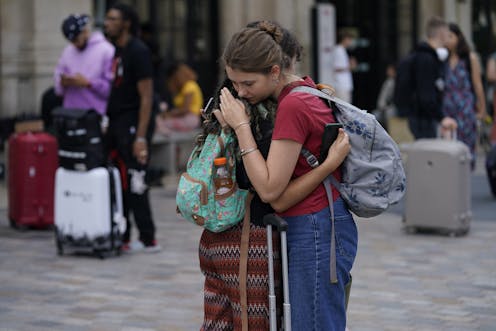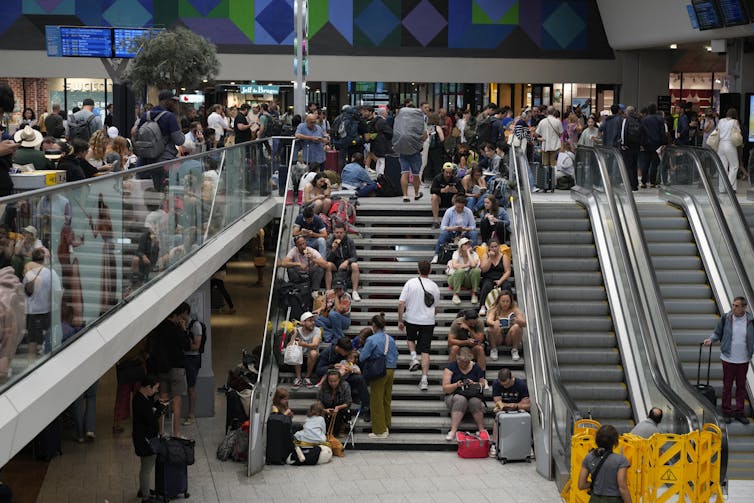Olympic arson attacks highlight growing danger of low-tech terrorism on public transit systems
Al-Qaida propaganda indicates a shift toward low-tech, high-impact attacks that can be executed by lone actors to disrupt daily life and instill fear on a massive scale.

As the Olympic torch was carried toward Paris for the 2024 Summer Games, flames of another kind were causing concern for the city’s security chiefs. On the eve of the July 26 opening ceremony, a series of arson attacks disrupted travel into the capital along a high-speed rail network.
Fortunately, no one was hurt in the series of small fires that brought trains to a halt on three major lines; nor has there been any claim of responsibility. But the incident exposed a vulnerability long known to security experts. Terrorist groups, too, have long seen passenger trains as attractive targets. Just months prior to the Paris incident, al-Qaida had been promoting train stations as potential targets.
As a defense researcher who focuses on how militant groups think and act, I see the Paris incident as a stark warning. Terrorist groups have long earmarked rail systems as a stage for attacks ranging from “spectaculars” – that is, coordinated, simultaneous acts designed to cause maximum amount of disruption, harm and panic – to lower-level disruptive acts. The persistent evolution in extremists’ tactics presents a critical challenge to global security, particularly when it comes to public transportation. The rail lines that connect cities around the world remain uniquely vulnerable to threats both old and new.
Low-tech, high-impact attacks
The attacks in France not only disrupted physical infrastructure, they also instilled widespread fear and uncertainty, especially given that Paris is a city still scarred with the memory of recent terrorist attacks.
Authorities were quick to describe the arson attack as “criminal acts” rather than terrorism.
But they were clearly the result of sophisticated planning and a high degree of coordination. And aspects of the France attack reflect recent terrorist thinking.
On Dec. 30, 2023, al-Qaida released a promotional video for the upcoming issue of its online magazine Inspire, focusing on train stations as targets.
The propaganda revisits the theme of rail vulnerabilities and encourages methods such as arson. This suggests a strategic shift toward low-tech, high-impact attacks that can be executed by individuals to disrupt daily life on a massive scale.
This tactical shift is not just a blueprint for chaos but a psychological strategy designed to instill fear and paralysis in millions of commuters.
Trains are symbols of routine and reliability. An attack on them can shatter that sense of everyday safety and infuse a pervasive atmosphere of fear and vulnerability.
In Europe, in particular, there are painful memories of such attacks; the 2004 Madrid train bombings killed 192 people and injured over 2,000, and a year later the 2005 London bombings on a bus and tube trains resulted in the death of 52 people and injured more than 700.
The timing and location of the Paris arson attacks – just as the city was gearing up for a global celebration, the Olympic Games – magnify their impact, extending the psychological reach far beyond the immediate physical damage.
The economic repercussions can also be dire. The immediate effects include repair costs and heightened security expenditures, but the broader economic disruptions – delays, lost tourism revenue and shaken investor confidence in the region’s stability – can linger long after the tracks are cleared.
Cities like Paris, reliant on their robust public transport systems, face significant economic setbacks from such attacks, which can stifle economic activity and growth. The timing of the Paris incident meant not only local commuters were affected but also international visitors, potentially leading to a ripple effect across the global perception of security in European transport hubs.
Maximizing damage and casualties
Terrorist groups are well aware of these long-lasting effects of an attack on rail networks – it is a theme that has been prominently featured in terrorist propaganda.

For example, the 17th issue of al-Qaida in the Arabian Peninsula’s Inspire magazine, released in August 2017, detailed a simple method for derailing trains by placing obstructions on the tracks – a tactic that requires no advanced technical skills, only the resolve to create havoc.
Inspire’s strategic insights suggest targeting trains near critical structures such as mountains, buildings, bridges or tunnels to maximize impact, damage and casualties. The magazine notes that “5.6 million passengers ride the New York subway every day, and in France, 15,000 trains pass through 3,000 stations daily,” highlighting the intent to inspire attacks on densely populated, high-impact targets.
Even years after its publication, the August 2017 issue of Inspire has been circulated repeatedly, especially at times of major geopolitical events such as the U.S. withdrawal from Afghanistan and the Israel-Hamas conflict.
And al-Qaida continues to encourage lone actors to undertake attacks that can disrupt major urban centers, leveraging the widespread accessibility of the proposed methods.
Rail systems are vulnerable
Rail networks are an attractive target for terrorists for several reasons. They are inherently accessible, often lightly secured and can be densely packed. The very efficiency and openness that make urban rail systems the lifeblood of a city also render them vulnerable to attacks.
Additionally, the potential for high casualties and significant media coverage ensures that even a small act can send shock waves of disruption both locally and internationally.
In the U.S., the risk of violent extremists’ attacks on critical infrastructure remains alarmingly high. From 2016 to 2022, U.S. federal courts charged 94 individuals with planning violent extremist attacks, 35 of whom specifically targeted critical infrastructure. Notably, 19 of these individuals were jihadists affiliated with the Islamic State in Iraq and Syria and al-Qaida. And of the seven jihadist plots involving transportation, five targeted mass transit and public rail services.
Wake-up call
The attacks on Paris’ rail lines should serve as a wake-up call.
The continuous circulation of Inspire magazine’s issues and the recent promotional push for al-Qaida’s “open source jihad” campaign underscore a grim reality: The terrorist threat is evolving, adapting new forms of low-tech tactics that exploit the vulnerabilities of critical infrastructure such as railways.
This evolution marks a significant shift in terrorist strategy, moving from spectacular, resource-heavy plots to simpler, more accessible forms of disruption that any individual can execute without formal training or support networks.
The simplicity and low-tech nature of the sabotage methods prescribed in terrorist propaganda make preventing such attacks challenging, but it is a necessary endeavor to ensure the safety of millions who rely on public transportation daily.
Sara Harmouch does not work for, consult, own shares in or receive funding from any company or organization that would benefit from this article, and has disclosed no relevant affiliations beyond their academic appointment.
Read These Next
The world risks forgetting one of humanity’s greatest triumphs as polio nears global eradication − 7
Polio may finally be defeated in the next 5 years. Will the world recognize what an extraordinary achievement…
People are getting their news from AI – and it’s altering their views
Even when information is factually accurate, how it’s presented can introduce subtle biases. As large…
Autocracies in transition: In 2025, Cameroon and Tanzania rulers clung to power — but look more vuln
The countries, whose respective leaders recently won widely disputed elections, offer contrasting examples…






